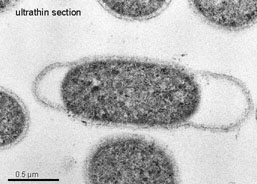Prokaryotes are by far the most successful superkingdom in terms of types of both biochemical diversity and the variety of environments conquered. Bacteria can be found living in all kinds of adverse conditions; from high alkaline lakes, to below freezing temperature, to hot volcanic vents which in some cases can reach temperatures close to the boiling point of water.
Thermotoga is a small genus of bacteria that contains some of the most hyperthermophilic species known, some able to survive at 90°C although most prefer the cooler temperatures of 70-80°C. It’s called “thermotoga” because it lives at high temperatures (thermo) and contains a characteristic outer cell membrane known as the ‘toga’.
One of the most interesting things about thermophilic bacteria (i.e bacteria that like living at very high temperatures) is their enzymes. Most normal enzymes, (most normal proteins in fact!) will break down and denature at very high temperatures, so bacteria like thermotoga will usually have their own set of enzymes. These enzymes are usually of great interest to people carrying out industrial processes, which all take place at higher temperatures. The most important enzyme in the PCR protocol (Taq polymerase, which synthesises DNA at temperatures of up to 80°C) was isolated from a marine thermophilic archaea.
Another exciting thing about Thermotoga is it has the ability to produce hydrogen. In the lab, it uses carbohydrates from yeast extract or peptone to form sugars, which are oxidised to carbon dioxide (or acetic acid) using either sulphur or protons as the electron acceptor. Where protons are used, they get reduced to hydrogen as the carbon dioxide is formed. The yield of hydrogen from glucose is very high, and in many cases can approach the theoretical maximum yield of for 4 mole hydrogen from one mole off glucose. This represents almost twice the amount that can be obtained from other bacterial hydrogen producers. Because this process is taking place at high temperatures, the enzymes involved in the process could potentially be used inside high temperature reactors.
Thermotoga neopolitana has the potential to produce one of the highest hydrogen yields of all as it is able to respire microaerobically. This means that it would be theoretically possible for the cells to aerobically oxidise a small amount of the glucose, generating enough energy to ensure that all the remaining glucose is fully oxidised by hydrogen-generating pathways. As yet, the metabolic pathways for oxygen use within these organisms have not been identified, but it does look as if hydrogen generation depends almost exclusively on anaerobic processes.

Electron micrograph of Thermotoga, showing the large outer cell wall covering (the toga!).
As the majority of the research into hydrogen production of Thermotoga has focussed on yield, issues of productivity, stability and required substrates will all need to be address in order for this process to be fully understood and possibly implemented in an industrial setting. There are also issues with biomass concentration – which is restricted, possibly by free-flowing biofilms (and possibly due to the toga-like nature of the surrounding cell-wall capsules. However even if large scale hydrogen production proves to be unfeasible with these microorganisms, studies of the enzymatic processes used to produce hydrogen at high temperatures may have applications above and beyond using the entire bacteria for hydrogen production.
---
Van Ooteghem, S., Beer, S., & Yue, P. (2002). Hydrogen Production by the Thermophilic Bacterium Thermotoga neapolitana Applied Biochemistry and Biotechnology, 98-100 (1-9), 177-190 DOI: 10.1385/ABAB:98-100:1-9:177



















3 comments:
That's one big toga! Do you have any idea what thermatoga is doing with all the extra space?
Arr, your skills at computer art are the same as mine! Very cute little roman toga-toting bacteria.
Thanks for the comments (this post came up automatically when I was on holiday, only just got back). I have no idea what the extra space is for, but one vague idea is that it might help with insulation, keeping the heat away with the bacteria. it certainly gets in the way of them forming biofilms.
Post a Comment